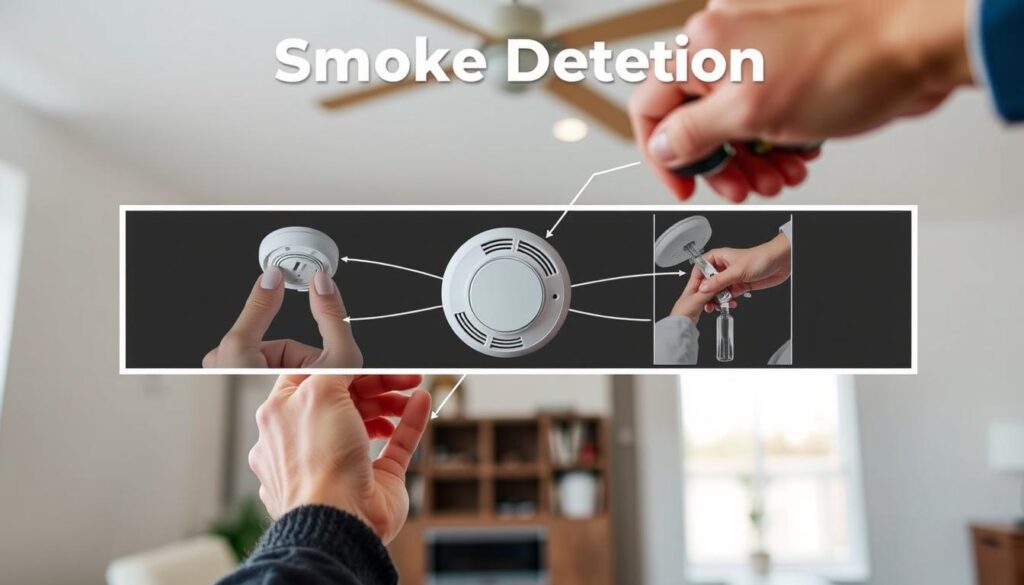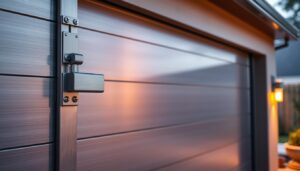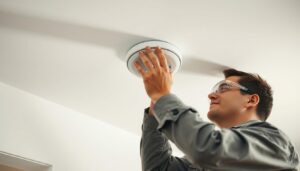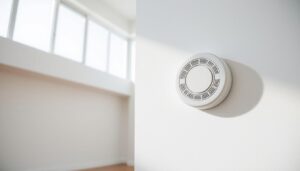House fires can start so quietly that occupants often remain unaware of the danger until it’s too late. Smoke detectors play a crucial role in home safety by alerting you to potential fires at an early stage, providing vital time to evacuate and call for help.
To ensure your home is equipped with an effective fire detection system, it’s essential to understand the importance of correctly installing smoke detectors. A well-planned installation can significantly enhance your home’s fire protection.
This comprehensive guide will walk you through the essential steps for installing smoke detectors correctly, covering the different types available, optimal placement, and step-by-step installation procedures for both battery-operated and hardwired detectors, ensuring your home remains a safe haven for you and your family.
Key Takeaways
- Understand the critical role of smoke detectors in home fire safety.
- Learn about the different types of smoke detectors and their optimal placement.
- Discover step-by-step installation procedures for battery-operated and hardwired smoke detectors.
- Gain insights into maintaining your smoke detection system for reliable protection.
- Ensure compliance with UK fire safety regulations through proper installation.
Why Proper Smoke Detector Installation Is Critical
Understanding the importance of proper smoke detector installation can be the difference between life and death in the event of a fire. “Smoke alarms save lives,” as emphasized by fire safety experts, and their correct installation is paramount.
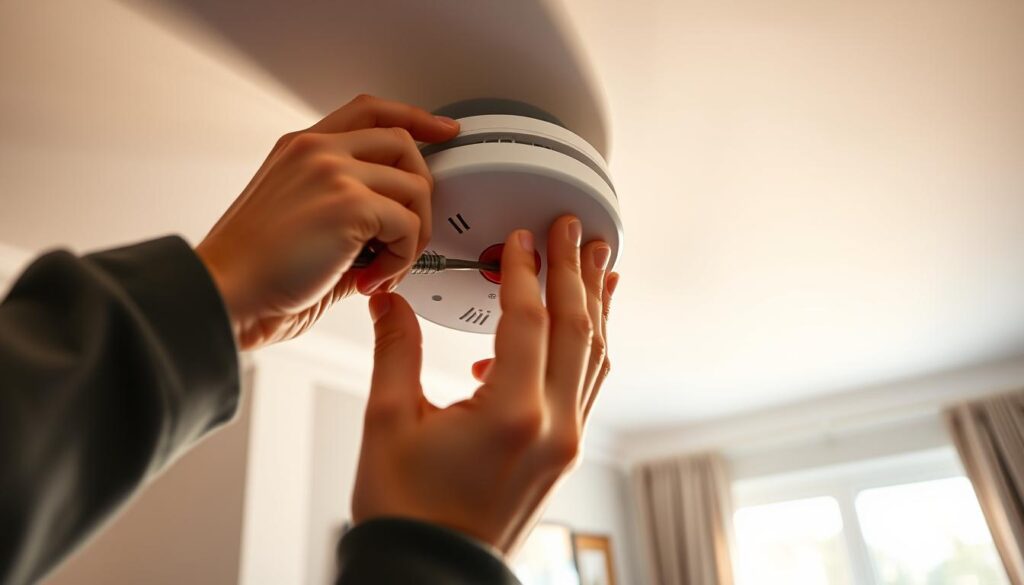
Life-Saving Benefits of Smoke Detectors
Smoke detectors provide an early warning in the event of a fire, allowing occupants to evacuate the premises quickly. This early detection is crucial for reducing the risk of injury or fatality. In fact, having working smoke alarms in your home can halve the risk of dying in a fire.
UK Fire Safety Regulations and Requirements
The UK has specific fire safety regulations regarding the installation of smoke alarms in residential properties. For instance, the Building Regulations Approved Document B (Fire Safety) outlines the requirements for domestic smoke alarm installation. Landlords, in particular, have legal responsibilities to ensure that smoke alarms are installed and maintained in rental properties. Compliance with these regulations is not only a legal necessity but also essential for insurance purposes.
It’s your responsibility to ensure that smoke detector locations comply with any applicable building regulations. This includes understanding the specific requirements for new builds versus existing properties, including the minimum number of alarms required and their mandatory locations within a property.
Types of Smoke Detectors for Home Safety
When it comes to home safety, selecting the right type of smoke detector is crucial. Your choice can significantly impact the effectiveness of your home’s safety measures.
Battery-Operated Smoke Detectors
Battery-operated smoke detectors are a popular choice due to their ease of installation and cost-effectiveness. They are ideal for homes where hardwiring is not feasible. However, it’s essential to regularly check and replace the batteries to ensure they function correctly.
Hardwired Smoke Detectors
Hardwired smoke detectors are directly connected to your home’s electrical system, providing a reliable source of power. They often come with battery backups in case of a power outage, ensuring continuous protection. These detectors are particularly suitable for new constructions or during major renovations.
Combination Smoke and Carbon Monoxide Detectors
Combination smoke and carbon monoxide detectors offer dual protection against both smoke and the silent killer, carbon monoxide. These detectors are especially beneficial in homes with gas appliances, boilers, or fireplaces. They detect different threats and produce distinct alarm sounds to indicate whether the danger is smoke or carbon monoxide.
Installing combination detectors near sleeping areas and in proximity to gas-fuelled appliances is recommended. In the event of a carbon monoxide alarm activation, immediately ventilate the area, evacuate the property, and contact the Gas Emergency service on 0800 111 999.
Optimal Placement of Smoke Detectors in Your Home
The effectiveness of smoke detectors largely depends on their strategic placement within your home. Proper installation ensures that smoke detectors can detect fires promptly, providing crucial early warnings to occupants.
Recommended Locations Throughout the House
For comprehensive coverage, smoke detectors should be installed on every level of your home and inside or near sleeping areas. It’s advisable to place them in hallways outside bedrooms and on landings. Ensure that detectors are positioned away from kitchens and bathrooms to minimize false alarms caused by steam or cooking fumes.
Installation on Flat Ceilings
On flat ceilings, smoke detectors should be mounted as centrally as possible. The ideal location is at least 300mm away from any wall or light fitting. This central positioning helps in capturing smoke more effectively, as it tends to spread out evenly across the ceiling.
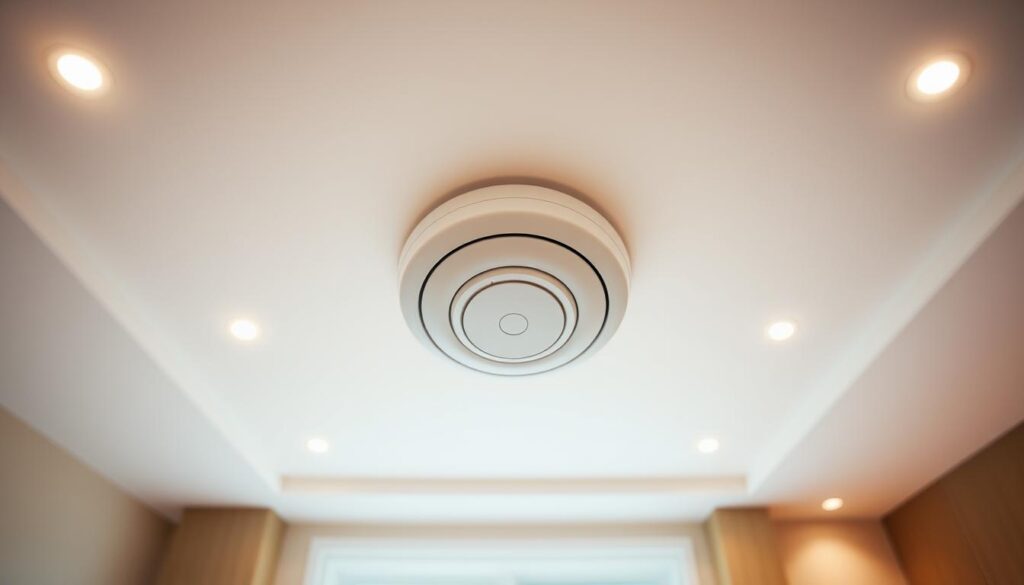
Installation on Sloped Ceilings
For homes with sloped or pitched ceilings, the installation rules differ slightly. The detector should be placed within 600mm vertically from the peak of the ceiling when measuring along the slope. It’s also crucial to position the sensor as centrally as possible to the ceiling area. Special brackets or adapters may be required to ensure the detector is mounted correctly on the sloped ceiling, maintaining its effectiveness.
Understanding these guidelines helps you to install smoke detectors effectively, enhancing your home’s safety against fires.
Installing Smoke Detectors Correctly: Step-by-Step Guide
To ensure your home is equipped with a reliable fire safety system, installing smoke detectors correctly is crucial. This guide will walk you through the process, ensuring you can safeguard your home and family effectively.
Tools and Materials You’ll Need
Before starting the installation, gather the necessary tools and materials. You’ll need a smoke detector, a screwdriver, and potentially a drill if you’re installing on a wall or ceiling. For hardwired smoke detectors, ensure you have the appropriate electrical knowledge and tools, such as wire strippers and a voltage tester.
Installing Battery-Operated Smoke Detectors
Installing battery-operated smoke detectors is relatively straightforward. Begin by mounting the base plate to the wall or ceiling using the provided screws.
Mounting the Base Plate
Align the base plate with the mounting holes and screw it into place. Ensure it’s securely fastened to support the weight of the detector.
Connecting the Battery and Testing
Insert the battery into the detector, ensuring it’s properly connected. Test the detector by pressing the test button; it should sound an alarm. This confirms the detector is working correctly.
Installing Hardwired Smoke Detectors
For hardwired smoke detectors, the process involves working with electrical wiring. It’s essential to follow safety precautions to avoid electrical shock.
Safety Precautions When Working with Electricity
Turn off the power to the circuit you’re working on at the circuit breaker or fuse box. Verify the power is off using a voltage tester. This step is crucial for your safety.
Wiring and Mounting Process
Wiring the smoke detectors involves installing old-work electrical boxes where the detectors will be placed. Run a 2-wire cable from the power source to the first smoke detector. Then, use 3-wire cables to link multiple detectors together. Secure the cables within wall and ceiling cavities according to building regulations. Mount the detector base plate to the electrical box, make the necessary wire connections, and attach the detector unit. Finally, test the installation to ensure all detectors are properly powered and interconnected.
Testing and Maintaining Your Smoke Detectors
To ensure your smoke detectors are functioning correctly, regular testing and maintenance are crucial. This not only guarantees their effectiveness in warning you of potential fires but also prolongs their operational lifespan.
Regular Testing Procedures
You should test your smoke detectors monthly. Most models come with a test button that you press to check if the alarm sounds. If it doesn’t, it may indicate a problem with the battery or the detector itself. It’s essential to follow the manufacturer’s instructions for testing. Some detectors may have different testing procedures.
Battery Replacement Schedule
Battery-operated smoke detectors require their batteries to be replaced regularly. Typically, this should be done annually, but it’s wise to check the manufacturer’s guidelines. Some batteries may last longer, and using the correct replacement battery is crucial.
Cleaning and Maintenance Tips
Cleaning your smoke alarm every few months is recommended. Use a slightly damp cloth or a soft brush attachment on a vacuum cleaner to gently remove dust. Be cautious not to knock the sensor while cleaning, as this may trigger a false alarm. Avoid using solvents, cleaners, or painting the alarm, as these actions can damage the sensor or block smoke entry points.
Regular maintenance not only ensures your smoke detectors are working correctly but also helps prevent false alarms. Remember, smoke detectors typically need to be replaced every 10 years, regardless of whether they appear to be functioning.
Conclusion: Ensuring Ongoing Fire Safety in Your Home
Ensuring your home is equipped with functioning smoke detectors is crucial for the safety of your family and property. Throughout this guide, we’ve covered the critical importance of correctly installed and maintained smoke detectors in preventing fire-related tragedies. By understanding the different types of smoke detectors and their optimal placement, you can significantly enhance your home’s fire safety.
Regular testing and maintenance of your detectors are vital to ensure they remain operational. Additionally, creating and practising a family evacuation plan can provide comprehensive fire safety. By following the guide and tips provided, you can protect your family and property from the dangers of fire. Take immediate action to implement these measures and enjoy a safer living environment.
